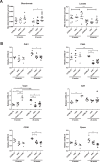Cmah-dystrophin deficient mdx mice display an accelerated cardiac phenotype that is improved following peptide-PMO exon skipping treatment
- PMID: 30281092
- PMCID: PMC6337703
- DOI: 10.1093/hmg/ddy346
Cmah-dystrophin deficient mdx mice display an accelerated cardiac phenotype that is improved following peptide-PMO exon skipping treatment
Abstract
Duchenne muscular dystrophy (DMD) is caused by loss of dystrophin protein, leading to progressive muscle weakness and premature death due to respiratory and/or cardiac complications. Cardiac involvement is characterized by progressive dilated cardiomyopathy, decreased fractional shortening and metabolic dysfunction involving reduced metabolism of fatty acids-the major cardiac metabolic substrate. Several mouse models have been developed to study molecular and pathological consequences of dystrophin deficiency, but do not recapitulate all aspects of human disease pathology and exhibit a mild cardiac phenotype. Here we demonstrate that Cmah (cytidine monophosphate-sialic acid hydroxylase)-deficient mdx mice (Cmah-/-;mdx) have an accelerated cardiac phenotype compared to the established mdx model. Cmah-/-;mdx mice display earlier functional deterioration, specifically a reduction in right ventricle (RV) ejection fraction and stroke volume (SV) at 12 weeks of age and decreased left ventricle diastolic volume with subsequent reduced SV compared to mdx mice by 24 weeks. They further show earlier elevation of cardiac damage markers for fibrosis (Ctgf), oxidative damage (Nox4) and haemodynamic load (Nppa). Cardiac metabolic substrate requirement was assessed using hyperpolarized magnetic resonance spectroscopy indicating increased in vivo glycolytic flux in Cmah-/-;mdx mice. Early upregulation of mitochondrial genes (Ucp3 and Cpt1) and downregulation of key glycolytic genes (Pdk1, Pdk4, Ppara), also denote disturbed cardiac metabolism and shift towards glucose utilization in Cmah-/-;mdx mice. Moreover, we show long-term treatment with peptide-conjugated exon skipping antisense oligonucleotides (20-week regimen), resulted in 20% cardiac dystrophin protein restoration and significantly improved RV cardiac function. Therefore, Cmah-/-;mdx mice represent an appropriate model for evaluating cardiac benefit of novel DMD therapeutics.
Figures





Similar articles
-
Peptide-conjugated phosphodiamidate oligomer-mediated exon skipping has benefits for cardiac function in mdx and Cmah-/-mdx mouse models of Duchenne muscular dystrophy.PLoS One. 2018 Jun 18;13(6):e0198897. doi: 10.1371/journal.pone.0198897. eCollection 2018. PLoS One. 2018. PMID: 29912990 Free PMC article.
-
A fusion peptide directs enhanced systemic dystrophin exon skipping and functional restoration in dystrophin-deficient mdx mice.Hum Mol Genet. 2009 Nov 15;18(22):4405-14. doi: 10.1093/hmg/ddp395. Epub 2009 Aug 18. Hum Mol Genet. 2009. PMID: 19692354
-
Exon Skipping Therapy Using Phosphorodiamidate Morpholino Oligomers in the mdx52 Mouse Model of Duchenne Muscular Dystrophy.Methods Mol Biol. 2018;1687:123-141. doi: 10.1007/978-1-4939-7374-3_9. Methods Mol Biol. 2018. PMID: 29067660
-
Molecular correction of Duchenne muscular dystrophy by splice modulation and gene editing.RNA Biol. 2021 Jul;18(7):1048-1062. doi: 10.1080/15476286.2021.1874161. Epub 2021 Jan 20. RNA Biol. 2021. PMID: 33472516 Free PMC article. Review.
-
Current Translational Research and Murine Models For Duchenne Muscular Dystrophy.J Neuromuscul Dis. 2016 Mar 3;3(1):29-48. doi: 10.3233/JND-150113. J Neuromuscul Dis. 2016. PMID: 27854202 Free PMC article. Review.
Cited by
-
Delivery of oligonucleotide-based therapeutics: challenges and opportunities.EMBO Mol Med. 2021 Apr 9;13(4):e13243. doi: 10.15252/emmm.202013243. Epub 2021 Apr 6. EMBO Mol Med. 2021. PMID: 33821570 Free PMC article. Review.
-
What is the level of dystrophin expression required for effective therapy of Duchenne muscular dystrophy?J Muscle Res Cell Motil. 2019 Jun;40(2):141-150. doi: 10.1007/s10974-019-09535-9. Epub 2019 Jul 9. J Muscle Res Cell Motil. 2019. PMID: 31289969 Review.
-
High-Resolution HPLC for Separating Peptide-Oligonucleotide Conjugates.ACS Omega. 2025 Apr 30;10(20):20578-20584. doi: 10.1021/acsomega.5c01308. eCollection 2025 May 27. ACS Omega. 2025. PMID: 40454080 Free PMC article.
-
Bioconjugated Oligonucleotides: Recent Developments and Therapeutic Applications.Bioconjug Chem. 2019 Feb 20;30(2):366-383. doi: 10.1021/acs.bioconjchem.8b00761. Epub 2019 Jan 29. Bioconjug Chem. 2019. PMID: 30608140 Free PMC article. Review.
-
Enhancing the Effectiveness of Oligonucleotide Therapeutics Using Cell-Penetrating Peptide Conjugation, Chemical Modification, and Carrier-Based Delivery Strategies.Pharmaceutics. 2023 Apr 3;15(4):1130. doi: 10.3390/pharmaceutics15041130. Pharmaceutics. 2023. PMID: 37111616 Free PMC article. Review.
References
-
- Vry J., Gramsch K., Rodger S., Thompson R., Steffensen B.F., Rahbek J., Doerken S., Tassoni A., Beytia M.L., Guergueltcheva V. et al. (2016) European cross-sectional survey of current care practices for Duchenne muscular dystrophy reveals regional and age-dependent differences. J. Neuromuscul. Dis., 3, 517–527. - PMC - PubMed
-
- Eagle M., Baudouin S.V., Chandler C., Giddings D.R., Bullock R. and Bushby K. (2002) Survival in Duchenne muscular dystrophy: improvements in life expectancy since 1967 and the impact of home nocturnal ventilation. Neuromuscul. Disord., 12, 926–929. - PubMed
-
- Nigro G., Comi L.I., Politano L. and Bain R.J. (1990) The incidence and evolution of cardiomyopathy in Duchenne muscular dystrophy. Int. J. Cardiol., 26, 271–277. - PubMed
Publication types
MeSH terms
Substances
Grants and funding
- RG/11/9/28921/BHF_/British Heart Foundation/United Kingdom
- FS/10/002/28078/BHF_/British Heart Foundation/United Kingdom
- PG/14/2/30595/BHF_/British Heart Foundation/United Kingdom
- MR/N024850/1/MRC_/Medical Research Council/United Kingdom
- RG/11/9/28921 /BHF_/British Heart Foundation/United Kingdom
- MR/R025312/1/MRC_/Medical Research Council/United Kingdom
- FS/10/002/28078 /BHF_/British Heart Foundation/United Kingdom
- FS/19/18/34252/BHF_/British Heart Foundation/United Kingdom
- FS/14/17/30634/BHF_/British Heart Foundation/United Kingdom
- G0900887/MRC_/Medical Research Council/United Kingdom
- G0601490/MRC_/Medical Research Council/United Kingdom
- MC_U105178803/MRC_/Medical Research Council/United Kingdom
- MR/L013142/1/MRC_/Medical Research Council/United Kingdom
LinkOut - more resources
Full Text Sources
Molecular Biology Databases
Miscellaneous

